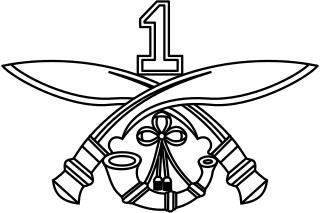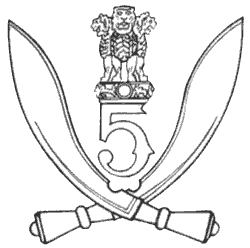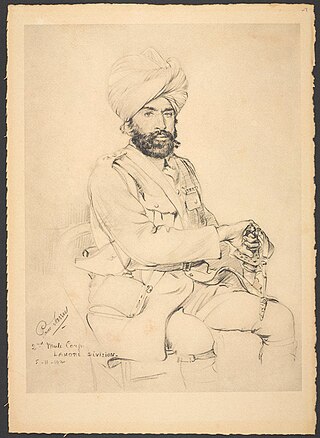
The 2nd King Edward VII's Own Gurkha Rifles (The Sirmoor Rifles) was a rifle regiment of the British Indian Army before being transferred to the British Army on India's independence in 1947. The 4th Battalion joined the Indian Army as the 5th Battalion, 8th Gorkha Rifles (Sirmoor Rifles), where it exists to this day. As part of the British Army, the regiment served in Malaya, Hong Kong and Brunei until 1994 when it was amalgamated with the other three British Army Gurkha infantry regiments to form the Royal Gurkha Rifles. It is the only Gurkha regiment which did not have a khukuri on its cap badge.
The 10th Princess Mary's Own Gurkha Rifles,, was originally a rifle regiment of the British Indian Army. The regiment was formed in 1890, taking its lineage from a police unit and over the course of its existence it had a number of changes in designation and composition. It took part in a number of campaigns on the Indian frontiers during the 19th and early 20th centuries, before fighting in the First World War, the Third Anglo-Afghan War and the Second World War. Following India's independence in 1947, the regiment was one of four Gurkha regiments to be transferred to the British Army. In the 1960s it was active in the Malayan Emergency and Indonesian Confrontation. It was amalgamated with the other three British Gurkha regiments to form the Royal Gurkha Rifles in 1994.

1st Gorkha Rifles (The Malaun Regiment), often referred to as the 1st Gorkha Rifles, or 1 GR in abbreviation, is the most senior Gorkha Infantry regiment of the Indian Army, comprising Gurkha soldiers of Indian Gorkha or Nepalese nationality, especially Magars and Gurungs, hill tribes of Nepal. It was originally formed as part of the East India Company's Bengal Army in 1815, later adopting the title of the 1st King George V's Own Gurkha Rifles (The Malaun Regiment), however, in 1947, following the partition of India, it was transferred to the Indian Army and in 1950 when India became a Republic, it was redesignated as 1st Gorkha Rifles (The Malaun Regiment). The regiment has a long history and has participated in many conflicts, including many of the colonial conflicts prior to Indian independence, as well as the First and Second World Wars. Since 1947 the regiment has also participated in a number of campaigns against Pakistan in 1965 and 1971 as well as undertaking peacekeeping duties as part of the United Nations.

The 3rd Gorkha Rifles or Third Gorkha Rifles, abbreviated as 3 GR is an Indian Army infantry regiment. It was originally a Gurkha regiment of the British Indian Army formed in 1815. This regiment recruit mainly Magars and Gurung tribes. They were present at a number of actions and wars including the siege of Delhi in 1857 to the First and Second World Wars. After the Partition of India in 1947 the regiment was one of the six Gorkha regiments transferred to the Indian Army as part of the Tripartite Agreement signed between India, Nepal and Britain at the time of Indian independence. Prior to independence, the regiment was known as the 3rd Queen Alexandra's Own Gurkha Rifles. In 1950 the regiment's title was changed to 3rd Gorkha Rifles. Since 1947 the regiment has participated in a number of conflicts including the 1947 and 1971 wars against Pakistan.

5th Gorkha Rifles, also abbreviated as 5 GR(FF) is an infantry regiment of the Indian Army comprising Gurkha soldiers of Nepalese origin. It was formed in 1858 as part of the British Indian Army. The regiment's battalions served in the First World War (Mesopotamia) and Second World War.

The 7th Gurkha Rifles was a rifle regiment of the British Indian Army, before being transferred to the British Army, following India's independence in 1947 and after 1959 designated as the 7th Duke of Edinburgh's Own Gurkha Rifles.
The Order of battle of the Chindits, an Allied special force which carried out two deep penetration raids behind Japanese line during the Burma campaign in the South-East Asian Theatre of World War II

The 19th Indian Infantry Division was an infantry division of the Indian Army during World War II, and played a prominent part in the final part of the Burma Campaign.

The 8th Gorkha Rifles is a Gorkha regiment of the Indian Army. It was raised in 1824 as part of the British East India Company and later transferred to the British Indian Army after the Indian Rebellion of 1857. The regiment served in World War I and World War II, before being one of the six Gurkha regiments transferred to the Indian Army after independence in 1947. Since then it has served in a number of conflicts including the Sino-Indian War of 1962 and the Indo-Pakistan wars of 1965 and 1971. Today the 8th Gorkha Rifles is one of the most celebrated regiments of the Indian Army, having received numerous citations for bravery in the field of battle, and even producing one of the two field marshals of India, Field Marshal Sam Manekshaw, of the Indian Army.

The 9th Gorkha Rifles is a Gorkha infantry regiment of the Indian Army and, previously, the British Army. The regiment was initially formed by the British in 1817, and was one of the Gurkha regiments transferred to the Indian Army after independence as part of the tripartite agreement in 1947. This Gorkha regiment mainly recruits soldiers who come from Nepal's Gorkhali Kshatriya community i.e. the Chhetri and Thakuri clans. Domiciled Indian Gorkhas are also recruited, and they form about 20 percent of the regiment's total strength. The 9 Gorkha Rifles is one of the seven Gorkha regiments of the Indian Army. The other regiments are 1 GR, 3 GR, 4 GR, 5 GR (FF), 8 GR and 11 GR.

The 23rd Indian Infantry Division was an infantry division of the Indian Army during World War II. It fought in the Burma Campaign. It was then reformed as a division of the independent Indian Army in 1959.

The Bengal Army was the army of the Bengal Presidency, one of the three presidencies of British India within the British Empire.

The 7th (Meerut) Division was an infantry division of the Indian Army and before 1895, the Bengal Army, that saw active service during World War I.

The 3rd (Lahore) Division was an infantry division of the Indian Army and before 1895, the Bengal Army, first organised in 1852. It saw service during World War I as part of the Indian Corps in France before being moved to the Middle East where it fought against troops of the Ottoman Empire.
The 2nd Indian Infantry Brigade was an infantry brigade formation of the Indian Army during World War II. It was formed in Rawalpindi in September 1939. In October 1940, it was renamed 16th (Independent) Indian Infantry Brigade in November 1941, and left India for Burma. The brigade was caught in the Battle of Sittang Bridge where it suffered heavy losses. Instead of being reformed in September 1942, it was renamed yet again, this time to 116th Indian Infantry Brigade. Attached to the 39th Indian Infantry Division it now provided specialised jungle conversion training. An infantry battalion would spend from four to six months with the brigade, before being sent to the front to replace a tired battalion in one of the fighting divisions.
The 11th Gurkha Rifles was a Gurkha regiment of the British Indian Army. It was formed in Mesopotamia and Palestine in May 1918, saw active service in the First World War and the Third Anglo-Afghan War, and was disbanded in April 1922.
The 42nd Indian Brigade was an infantry brigade of the British Indian Army that saw active service with the Indian Army during the First World War. It served in the Mesopotamian Campaign on the Euphrates Front throughout its existence. It was not reformed for the Second World War.
The 41st Indian Brigade was an infantry brigade of the British Indian Army that saw service with the Indian Army during the First World War. It served in the Mesopotamian Campaign on the Euphrates Front throughout its existence. It was not reformed for the Second World War.















